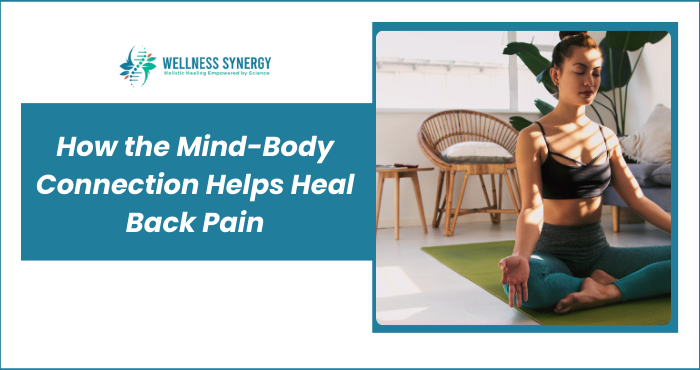How the Mind-Body Connection Helps Heal Back Pain
Back pain is something many people deal with, and it can range from a mild ache to sharp pain or stiffness that limits movement. It can affect anyone, no matter their age or background, and often leads people to seek treatments like physical therapy, medication, or even surgery. But there’s something important that’s often overlooked: the mind-body connection. The mind and body are closely linked, and understanding how this relationship affects pain can be the key to healing. Traditional treatments focus on the physical causes of back pain, but the mind-body connection suggests that emotional and mental factors also play a big role. In this post, we’ll look at how this connection helps heal back pain and how you can use it for better wellness holistic health.
What is the Mind-Body Connection?
The mind-body connection is how your thoughts, feelings, and physical health are linked. What you think and feel can affect your body, and your body can influence your emotions. For example, stress can cause your muscles to tighten, which can lead to back pain. Similarly, physical pain can make you feel upset, anxious, or even sad, which can make the pain feel worse. In simple terms, your mind and body work together. If one is out of balance, it can affect the other and create a cycle that leads to problems like back pain. That’s why it’s important to consider both your physical and mental health when treating back pain for lasting relief.
How Stress & Emotions Affect Back Pain
Stress, anxiety, and negative emotions can make back pain worse. When you’re stressed, your body releases stress hormones like cortisol, which can cause muscles to tense up and inflame, especially in the back. Also, stress can make you adopt poor posture. When anxious or worried, you may hunch your shoulders, tighten your muscles, or put strain on your spine without realizing it. Over time, this can worsen back pain. Negative emotions like fear, frustration, or sadness can also make pain feel stronger and last longer. The mind has a lot of power, and negative feelings can intensify the experience of pain. This is why people with chronic pain often feel emotionally drained and mentally tired.
How Mindfulness Can Help Heal Back Pain
One of the best ways to work with the mind-body connection in healing back pain is through mindfulness. Mindfulness is about focusing on the present moment without judgment. By becoming aware of your thoughts, feelings, and body sensations, you can lower stress and relax your body. Mindfulness activities like deep breathing, meditation, and body scans can help relax your muscles, calm your mind, and reduce stress. This helps ease back muscle tension and supports healing. Mindfulness also helps you become aware of your posture and movements, which can prevent further strain on your back.
Combining Physical & Emotional Treatment for Back Pain
Healing back pain is not just about treating the physical symptoms. It’s important to treat both the body and the mind. Here are a few ways to do this:
- Exercise and Physical Therapy: Regular physical activity like stretching, strengthening exercises, and walking can help reduce back pain. Exercise also boosts mental health by releasing endorphins (the body’s natural painkillers) and helps you relax, which can break the cycle of pain and stress.
- Cognitive Behavioral Therapy (CBT): CBT helps people change negative thinking patterns. For those with chronic back pain, CBT can help address the emotional factors that make pain worse. By learning how to think differently and manage stress, you can improve your response to pain.
- Yoga and Tai Chi: These exercises focus on mindfulness, breathing, and movement. They can increase flexibility, strengthen muscles, and reduce stress, all of which help with back pain. They also promote body awareness, which can prevent poor posture and muscle tension.
- Massage Therapy: Massage can help relax tight muscles in the back and also reduce stress and anxiety, improving pain and recovery.
- Relaxation Techniques: Practices like deep breathing, progressive muscle relaxation, and guided imagery can help calm your mind and reduce stress, which in turn helps your muscles relax and improves overall health.
Conclusion
Back pain can be frustrating, but understanding the mind-body connection can offer new ways to heal. By addressing both the physical and emotional aspects of pain, you can break the cycle of stress and discomfort that often comes with back pain. Whether it’s through mindfulness, positive thinking, exercise, or therapy, focusing on the mind-body connection can help you find lasting relief. Healing isn’t just about treating the body—it’s about taking care of your mind and emotions too, to achieve a balanced approach to health. At Wellness Synergy, we believe in the power of the mind-body connection to improve overall health. We combine the latest research with holistic practices to address both the physical and mental sides of healing. If you’re ready to take control of your back pain and start your healing journey, visit us at Wellness Synergy today. By nurturing the mind-body connection, you can find relief, improve your quality of life, and experience better overall health.
Disclaimer:
Wellness Synergy, its products, and Dr. Ilka Tamar do not intend to cure, treat, heal, or prevent diseases or illnesses. These statements have not been evaluated by the Food and Drug Administration. The information on our social media and website is for informational purposes only and is not a substitute for medical advice or diagnosis from your physician or other healthcare professional. This information is meant for general wellness purposes and does not claim to diagnose, treat, or cure any illness or health condition. If you suspect you have a medical issue, please contact your physician or healthcare provider.
FAQ: How the Mind-Body Connection Helps Heal Back Pain
What is the mind-body connection?
The mind-body connection refers to how our thoughts, feelings, and physical health are connected. Our emotions can affect our body, and physical pain can impact our emotions. For example, stress can cause muscle tension, which can lead to back pain, and pain can make us feel sad or anxious, which can make the pain feel worse.
How can stress and emotions affect back pain?
When we’re stressed or anxious, our body releases stress hormones like cortisol, which can cause muscles to tighten and inflammation, especially in the back. Stress can also lead to poor posture, making back pain worse. Negative emotions like fear, frustration, or sadness can also make the pain feel stronger and last longer.
How can mindfulness help heal back pain?
Mindfulness helps by bringing awareness to the present moment. It encourages deep breathing, meditation, and body scans, which can relax the body and reduce stress. When we’re mindful, we become more aware of our posture and movements, helping to prevent strain on the back and ease muscle tension.
What are some ways to combine physical and emotional treatment for back pain?
To heal back pain, it’s important to address both the body and mind. Here are some ways to do that:
Relaxation Techniques: Deep breathing, progressive muscle relaxation, and guided imagery can help calm the mind and relax the body.
Exercise & Physical Therapy: Stretching and strengthening exercises, as well as regular movement, can reduce pain and improve mood by releasing natural painkillers called endorphins.
Cognitive Behavioral Therapy (CBT): CBT helps change negative thought patterns, reducing emotional stress and improving how you respond to pain.
Yoga and Tai Chi: These practices combine mindfulness with movement to increase flexibility, strength, and relaxation.
Massage Therapy: Massages help relax tight muscles and reduce stress.
Why is it important to treat both the body and the mind for back pain?
Back pain isn’t just about physical symptoms—it’s also about how your mental and emotional health affects your pain. When we focus on both the body and the mind, we can break the cycle of pain and stress. Treating only one side might not bring lasting relief. By addressing both, you’re more likely to find long-term healing.
Can my thoughts really impact my back pain?
Yes! Your thoughts and emotions have a big impact on your body. Stress and negative emotions can increase muscle tension and inflammation, leading to more pain. Changing your thoughts, practicing relaxation, and staying positive can help reduce your pain and improve healing.
How can I get started on using the mind-body connection for healing?
Start by incorporating mindfulness practices like deep breathing or meditation. Regular exercise and relaxation techniques will also help. If needed, consider therapy or support groups to manage emotional stress. The key is to find a balance between taking care of both your body and your mind.


